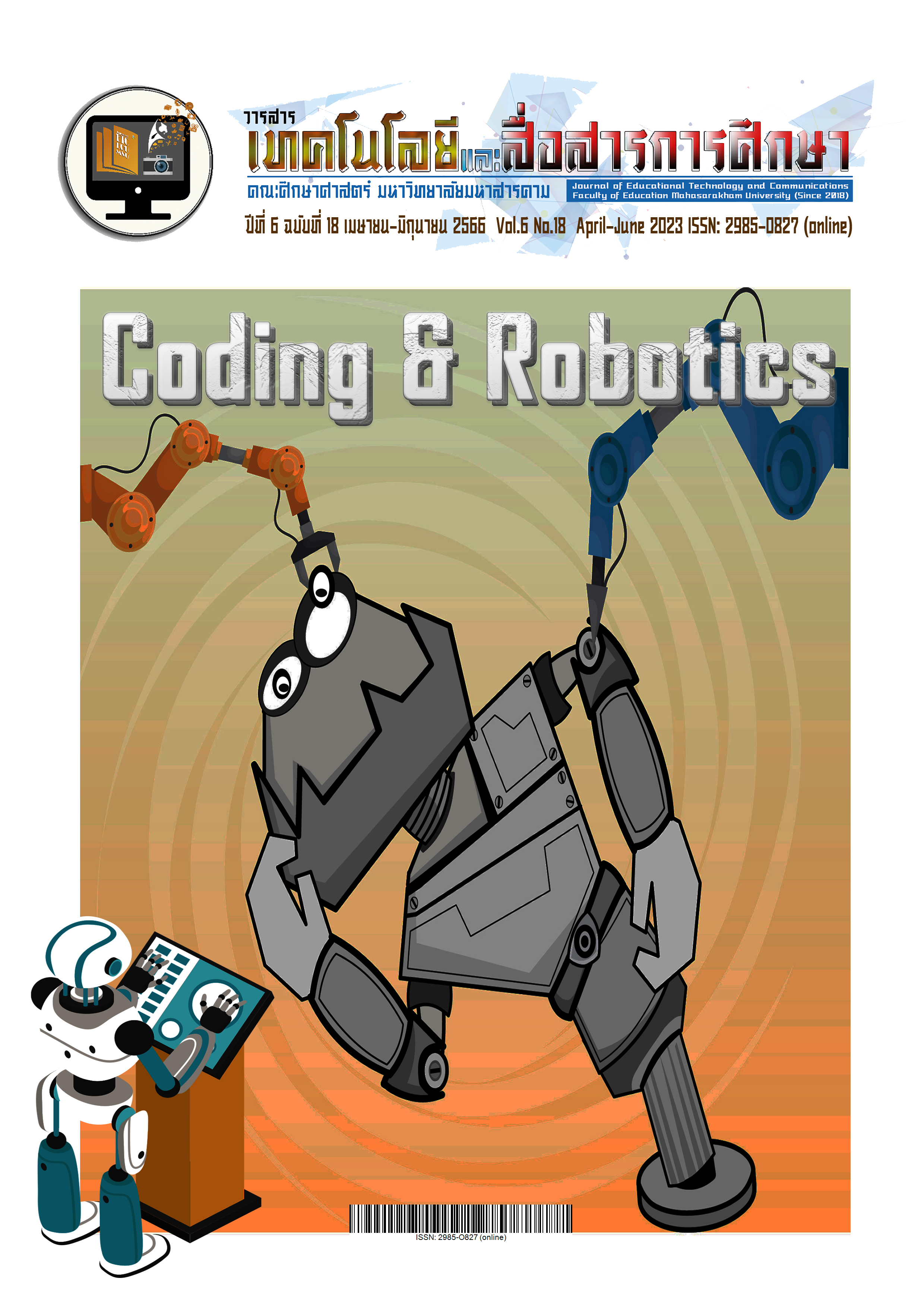การพัฒนาความสามารถการอ่านและการเขียนเชิงวิเคราะห์ภาษาอังกฤษของนักเรียนชั้นประถมศึกษาปีที่ 6 ตามแนวคิดการเรียนรู้เชิงรุกทฤษฎีการสร้างองค์ความรู้ การเรียนรู้โดยใช้งานเป็นฐาน และแผนผังกราฟิก
Main Article Content
บทคัดย่อ
การวิจัยครั้งนี้มีวัตถุประสงค์เพื่อ 1) พัฒนาความสามารถการอ่านและการเขียนเชิงวิเคราะห์ภาษาอังกฤษ ของนักเรียนชั้นประถมศึกษาปีที่ 6 ที่ได้รับการจัดการเรียนรู้ตามแนวคิดการเรียนรู้เชิงรุก ทฤษฎีการสร้างองค์ความรู้ การเรียนรู้โดยใช้งานเป็นฐานและแผนผังกราฟิก ตามเกณฑ์ร้อยละ 75 2) เปรียบเทียบความสามารถการอ่านและ การเขียนเชิงวิเคราะห์ภาษาอังกฤษ ของนักเรียนระหว่างก่อนเรียนและหลังเรียน โดยการจัดการเรียนรู้ตามแนวคิด การเรียนรู้เชิงรุก ทฤษฎีการสร้างองค์ความรู้ การเรียนรู้โดยใช้งานเป็นฐาน และแผนผังกราฟิก 3) เปรียบเทียบ ความสามารถการอ่านและการเขียนเชิงวิเคราะห์ ภาษาอังกฤษ ของนักเรียนที่ได้รับการจัดการเรียนรู้ตามแนวคิด การเรียนรู้เชิงรุกทฤษฎีการสร้างองค์ความรู้ การเรียนรู้โดยใช้งานเป็นฐานและแผนผังกราฟิกกับกลุ่มที่จัดการเรียนรู้ แบบปกติ และ 4) ศึกษาแรงจูงใจใฝ่สัมฤทธิ์ในการเรียนภาษาอังกฤษของนักเรียนที่ได้รับการจัดการเรียนรู้ตามแนวคิดการเรียนรู้เชิงรุกทฤษฎีการสร้างองค์ความรู้ การเรียนรู้โดยใช้งานเป็นฐานและแผนผังกราฟิก กลุ่มตัวอย่าง ได้แก่ นักเรียนชั้นประถมศึกษาปีที่ 6 โรงเรียนเทศบาล 5 (สมพรอภัยโส) จำนวน 17 คน เป็นกลุ่มทดลองจัดการเรียนรู้ตามแนวคิด ในการวิจัยครั้งนี้ และนักเรียนชั้นประถมศึกษาปีที่ 6/1 โรงเรียนเทศบาล 2 (ถนนบำรุงเมือง) จำนวน 25 คน เป็นกลุ่มจัดการเรียนรู้แบบปกติ ซึ่งได้มาโดยวิธีการสุ่มแบบกลุ่ม (Cluster Random Sampling) เครื่องมือที่ใช้จัดเก็บรวบรวมข้อมูล ประกอบด้วย 1) แบบทดสอบวัดความสามารถการอ่านและการเขียนเชิงวิเคราะห์ จำนวน 30 ข้อ 2) แบบประเมินแรงจูงใจใฝ่สัมฤทธิ์ทางการเรียนของนักเรียน ชนิดมาตราส่วนประมาณค่า 5 ระดับ จำนวน 20 ข้อ วิเคราะห์ข้อมูลโดยใช้ค่าเฉลี่ย ส่วนเบี่ยงเบนมาตรฐาน ร้อยละ และทดสอบสมมติฐานด้วย t-test (Dependent Sample) และ t-test (Independent Sample) ผลการวิจัยปรากฏดังนี้ 1. นักเรียนที่ได้รับการจัดการเรียนรู้ตามแนวคิดตามแนวคิดการเรียนรู้เชิงรุก ทฤษฎีการสร้างองค์ความรู้ การเรียนรู้โดยใช้งานเป็นฐาน และแผนผังกราฟิก มีความสามารถด้านการอ่านและการเขียนเชิงวิเคราะห์ภาษาอังกฤษ ก่อนเรียนและหลังเรียนโดยรวมเท่ากับ 15.12 และ 23.53 คิดเป็นร้อยละ 50.40 และ 84.43 ตามลำดับ แสดงว่า ค่าร้อยละของคะแนนความสามารถการอ่านและการเขียนเชิงวิเคราะห์หลังเรียนของนักเรียนสูงกว่าเกณฑ์ร้อยละ 75 ที่กำหนดไว้ 2. นักเรียนที่ได้รับการจัดการเรียนรู้ตามแนวคิดการเรียนรู้เชิงรุกทฤษฎีการสร้างองค์ความรู้ การเรียนรู้โดยใช้งานเป็นฐานและแผนผังกราฟิกภาษาอังกฤษ มีความสามารถการอ่านและการเขียนเชิงวิเคราะห์ หลังเรียนสูงกว่าก่อนเรียนอย่างมีนัยสำคัญทางสถิติที่ระดับ .05 3. นักเรียนที่ได้รับการจัดการเรียนรู้ตามแนวคิดการเรียนรู้เชิงรุก ทฤษฎีการสร้างองค์ความรู้ การเรียนรู้โดยใช้งานเป็นฐานและแผนผังกราฟิก มีความสามารถการอ่านและการเขียนเชิงวิเคราะห์ หลังเรียนสูงกว่ากลุ่มที่ได้รับการจัดการเรียนรู้แบบปกติ อย่างมีนัยสำคัญทางสถิติที่ระดับ .05 4. นักเรียนที่ได้รับการจัดการเรียนรู้ตามแนวคิดการเรียนรู้เชิงรุก ทฤษฎีการสร้างองค์ความรู้ การเรียนรู้โดยใช้งานเป็นฐาน และแผนผังกราฟิก ภาษาอังกฤษ มีแรงจูงใจใฝ่สัมฤทธิ์ในการเรียน ที่ค่าเฉลี่ยโดยรวมก่อนเรียนและหลังเรียนเท่ากับ 3.10 และ 3.84 ซึ่งอยู่ในระดับปานกลาง และระดับมาก ตามลำดับ
Downloads
Article Details
References
กระทรวงศึกษาธิการ. (2551). หลักสูตรแกนกลางการศึกษาขั้นพื้นฐานพุทธศักราช 2551. ุกระทรงศึกษาธิการ.
ชลรดี ช่างทอง, ดรุณนภา นาชัยฤทธิ์ และทิพาพร สุจารี. (2562). การพัฒนาความสามารถด้านการอ่านและการเขียนภาษาอังกฤษ โดยใช้กิจกรรมการเรียนรู้แบบ SQ4R ร่วมกับแผนผังกราฟิกของนักเรียนชั้นประถมศึกษาปีที่ 4. วารสารสถาบันวิจัยและพัฒนา มหาวิทยาลัยราชภัฏชัยภูมิ, 1(1), 9-23. https://so10.tci-thaijo.org/index.php/rdicpru/article/view/113
เพ็ญนภา ทัพพันธ์ และภัทร์ธีรา เทียนเพิ่มพูน. (2561). การพัฒนาแบบฝึกเสริมทักษะการอ่านภาษาอังกฤษเพื่อความเข้าใจโดยใช้กิจกรรมการเรียนรู้แบบเน้นภาระงาน สำหรับนักเรียนชั้นประถมศึกษาปีที่ 6. การประชุมนําเสนอผลงานวิจัยระดับบัณฑิตศึกษา ครั้งที่ 13 ปีการศึกษา 2561. (1816-1827). บัณฑิตวิทยาลัย มหาวิทยาลัย รังสิต.
เยาวลักษณ์ ภวะโชติ. (2563). การพัฒนากิจกรรมการเรียนรู้แบบเชิงรุกประกอบกับชุดฝึกทักษะการสื่อสารภาษาอังกฤษที่ส่งเสริมผลสัมฤทธิ์ทางการเรียนและความคิดสร้างสรรค์ของนักเรียนชั้นประถมศึกษาปีที่ 5. e-Journal of Education Studies, Burapha University, 2(4), 53-65. https://so01.tci-thaijo.org/index.php/ejes/article/view/242755
Balcan, M.F., Hanneke, S. & Vaughan, J.W. (2010). The true sample complexity of active learning. Springer, 111–139 . http://doi.org/10.1007/s10994-010-5174-y
Barkley, E. F., Major, C. H. & Cross, K. P. (2014). Collaborative Learning Techniques: A Handbook for Collage Faculty (2nd ed) Wiley
Berry, W. (2008). Surviving lecture: A pedagogical alternative. Taylor and Francis Online 56(3), 149-153. https://doi.org/10.3200/CTCH.56.3.149-153
Bhatia, V. K. (1993). Analyzing genre: Language use in professional settings. Longman.
Brown, A. & Green, T. D. (2011). The Essentials of Instructional Design: Connecting Fundamental Principles with Progress and Practice (2nd Ed), Allyn& Bacon.
Cook, J. L. & Cook, G. (2010). Child Development: Principles and Perspectives (2nd Ed), Pearson.
Ellis, R. (2003). Task-Based Language Learning and Teaching. Oxford University Press.
Ellis, R. (1994). The Study of Second Language Acquisition. Oxford University Press.
Gagnon, G. W. & Collay, M. (2006). Constructivist learning design: Key questions for teaching to standards. Corwin Press.
Gardner, R. C. (1985). Social psychology and second language learning: The role of attitudes and motivation. Edward Arnold.
Long, M, Wood., C., Littleton, K., Passeenger, T. & Sheehy, K. (2011). The Psychology of Education (2nd ed.), Routledge.
Michael, J. (2006). Where’s the evidence that active learning works?. Advances in Physiology Education, 50(4), 159-167. http://doi.org/10.1152/advan.00053.2006
Nunan, D. (1989). Designing Tasks for the Communicative Classroom. Cambridge University Press.
Skehan, P. (1996). A framework for the implementation of task-based instruction. Applied Linguistics, 17, 38-62.
Sternberg, R. J. (1985). Beyond IQ: A triarchic theory of human intelligence. Cambridge University Press.
Weaver, M. (2006). Do students value feedback? Student perceptions of tutor’s written responses. Assessment and Evaluation in Higher Education, 31, 379-394.

